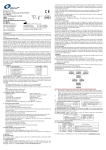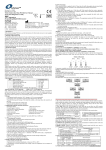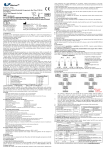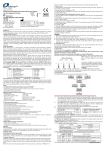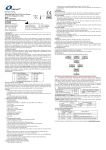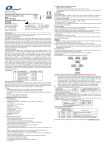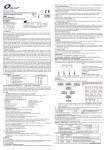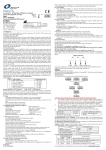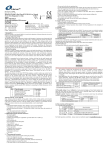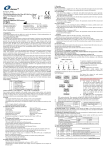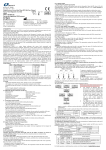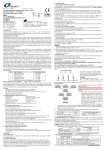Transcript
Revision No.: ZJ0008 Issue Date: Jul 1st, 2012 Mycoplasma Pneumoniae (MP) Real Time PCR Kit User Manual For In Vitro Diagnostic Use Only RD-0100-01 For use with LightCycler1.0/2.0 Instrument Obelis S.A. Boulevard Général Wahis 53 1030 Brussels, BELGIUM Tel: +(32) 2.732.59.54 Fax: +(32) 2.732.60.03 E-Mail : [email protected] Shanghai ZJ Bio-Tech Co., Ltd. www.liferiver.com.cn Tel: +86-21-34680596 [email protected] Fax: +86-21-34680595 2nd floor,No.15 Building,No.188 Xinjunhuan road, PuJiang Hi-tech Park Shanghai China 1. Intended Use MP real time PCR kit is used for the detection of mycoplasma pneumoniae by real time PCR systems in samples like nasal and pharyngeal secretions and swabs, sputum, provoked sputum, bronchial lavage, lung biopsy,pleural effusion and etc. 2. Principle of Real-Time PCR The principle of the real-time detection is based on the fluorogenic 5’nuclease assay. During PCR reaction, the DNA polymerase cleaves the probe at the 5’ end and separates the reporter dye from the quencher dye only when the probe hybridizes to the target DNA. This cleavage results in the fluorescent signal generated by the cleaved reporter dye, which is monitored real-time by the PCR detection system. The PCR cycle at which an increase in the fluorescence signal is detected initially (Ct) is proportional to the amount of the specific PCR product. Monitoring the fluorescence intensities during Real Time allows the detection of the accumulating product without having to re-open the reaction tube after the amplification. 3. Product Description Mycoplasma pneumoniae is an important etiological agent of community acquired infections of upper and lower respiratory tracts in children and young adults, mainly atypical pneumonia. M. pneumoniae has been reported as the cause of 25-30 % of all pneumonia cases. This pathogen has also been associated with non respiratory diseases as meningitis, encephalitis, pancreatitis or arthritis. Mycoplasma Pneumoniae real time PCR kit contains a specific ready-to-use system for the detection of mycoplasma pneumoniae by polymerase chain reaction (PCR) in the real-time PCR system. The master contains reagents and enzymes for the specific amplification of MP DNA. Fluorescence is emitted and measured by the real time systems´ optical unit during PCR. The detection of amplified MP DNA fragment is performed in fluorimeter channel 530nm with the fluorescent quencher BHQ1. DNA extraction buffer is available in the kit. In addition, the kit contains a system to identify possible PCR inhibition by measuring the 560nm fluorescence of the internal control (IC). 4 Kit Contents Ref. Type of Reagent Presentation 25rxns 1 DNA Extraction Buffer 2 vials, 1.5ml 2 MP Reaction Mix 1 vial, 450µl 3 PCR Enzyme Mix 1 vial, 12µl 4 Molecular Grade Water 1 vial, 400µl 5 Internal control 1 vial, 30µl 6 MP Positive Control 1 vial, 30µl 4 Analysis sensitivity:1×10 copies/ml Note: Analysis sensitivity depends on the sample volume, elution volume, nucleic acid extraction methods and other factors .If you use the DNA extraction buffer in the kit, the analysis sensitivity is the same as it declares. However, when the sample volume is dozens or even hundreds of times greater than elution volume by some concentrating method, it can be much higher. 5. Storage • All reagents should be stored at -20°C. Storage at +4°C is not recommended. • All reagents can be used until the expiration date indicated on the kit label. • Repeated thawing and freezing (>3x) should be avoided, as this may reduce the sensitivity of the assay. • Cool all reagents during the working steps. • Reaction Mix should be stored in the dark. 6. Additionally Required Materials and Devices • Biological cabinet • Real time PCR system • Trypsin digestive Solution • Vortex mixer • Real time PCR reaction tubes/plates • Cryo-container • Pipets (0.5 µl – 1000 µl) • Sterile filter tips for micro pipets • Sterile microtubes • Disposable gloves, powderless • Biohazard waste container • Refrigerator and Freezer • Tube racks • Desktop microcentrifuge for “eppendorf” type tubes (RCF max. 16,000 x g) 7. Warnings and Precaution Carefully read this instruction before starting the procedure. • For in vitro diagnostic use only. • This assay needs to be carried out by skilled personnel. • Clinical samples should be regarded as potentially infectious materials and should be prepared in a laminar flow hood. • This assay needs to be run according to Good Laboratory Practice. • Do not use the kit after its expiration date. • Avoid repeated thawing and freezing of the reagents, this may reduce the sensitivity of the test. • Once the reagents have been thawed, vortex and centrifuge briefly the tubes before use. • Prepare quickly the Reaction mix on ice or in the cooling block. • Set up two separate working areas: 1) Isolation of the RNA/ DNA and 2) Amplification/ detection of amplification products. • Pipets, vials and other working materials should not circulate among working units. • Use always sterile pipette tips with filters. • Wear separate coats and gloves in each area. • Avoid aerosols 8. Sample Collection, Storage and transport • Collect samples in sterile tubes; • Specimens can be extracted immediately or frozen at -20°C to -80°C. • Transportation of clinical specimens must comply with local regulations for the transport of etiologic agents 9. Procedure 9.1 DNA-Extraction DNA extraction buffer is supplied in the kit. Attention: please thaw the buffer thoroughly and mix the buffer well before use because it contains insoluble particles. You may use your own extraction systems or commercial kits. 9.1.1 Sputum sample 1) Trypsin digestive Solution preparation Add 10g trypsin to 200ml sterile purified water and mix thoroughly. Adjust the PH value to 8.0 with 2 % NaOH solution. Add 2mL 25mmol/L CaCl2, mix thoroughly and store at 4℃. Please incubate at 37℃ for 10 minutes before use. 2) Estimate the volume of the sputum and add partes aequales of the trypsin digestive solution then vortex vigorously. Set at room temperature for 30 minutes. Transfer 0.5ml mixture to a new tube. Centrifuge the tube at 13000rpm for 5 minutes, carefully remove and discard supernatant from the tube without disturbing the pellet. 3) Add 1.0ml normal saline. Resuspend the pellet with vortex vigorously. Centrifuge at 13000rpm for 5 minutes. Carefully remove and discard supernatant from the tube without disturbing the pellet. 4) Repeat step 3) 5) Add 50µl DNA extraction buffer, closed the tube then resuspend the pellet with vortex vigorously. Spin down briefly in a table centrifuge. 6) Incubate the tube for 10 minutes at 100°C. 7) Centrifuge the tube at 13000rpm for 10 minutes. The supernatant contains the DNA extracted and can be used for PCR template. 9.1.2 Fluid samples(nasal and pharyngeal secretions and etc.) 1) Take 1ml sample in a tube, centrifuge the tube at 13000rpm for 2min, and remove the supernatant and keep the pellet. 2) Add 100µl DNA extraction buffer to the pellet, close the tube then vortex for 10 seconds. Spin down briefly in a table centrifuge. 3) Incubate the tube for 10 minutes at 100°C. 4) Centrifuge the tube at 13000rpm for 10 minutes. The supernatant contains the DNA extracted and can be used for PCR template. 9.1.3 Tissue and swabs sample 1) Wash the sample (lung biopsy or swabs) in 0.5ml normal saline and vortex vigorously. Centrifuge at 13000rpm for 2 minutes. Carefully remove and discard supernatant from the tube without disturbing the pellet. 2) Add 100µl DNA extraction buffer to the tube, closed the tube then vortex for 10 seconds. 3) Incubation the tube for 10 minutes at 100°C. 4) Centrifuge the tube at 13000rpm for 5 minutes. The supernatant contains the extracted DNA and can be used for the template of the PCR. Attention: A. During the incubation, make sure the tube is not open. Since the vapor will volatilize into the air and may cause contamination if the sample is positive. B. The extraction sample should be used in 3 hours or stored at -20°C for one month. C. DNA extraction kits are available from various manufacturers. You may use your own extraction systems or the commercial kit based on the yield. For the DNA extraction, please comply with the manufacturer’s instructions. 9.2 Internal Control It is necessary to add internal control (IC) in the reaction mix. Internal Control (IC) allows the user to determine and control the possibility of PCR inhibition. Add the internal control (IC) 1µl/rxn and the result will be shown in the 560nm Channel. 9.3 PCR Protocol The Master Mix volume for each reaction should be pipetted as follows: ※PCR system without 560nm channel may be treated with 1µl Molecular Grade Water instead of 1µl IC. 1) The volumes of Reaction Mix and Enzyme Mix per reaction multiply with the number of samples, which includes the number of controls, standards, and sample prepared. Molecular Grade Water is used as the negative control. For reasons of unprecise pipetting, always add an extra virtual sample.Mix completely then spin down briefly in a centrifuge. 2) Pipet 18µl Master Mix with micropipets of sterile filter tips to each Real time PCR reaction plate/tubes. Then separately add 2µl DNA sample supernatant, positive and negative controls to different plates/tubes. Immediately close the plate/tubes to avoid contamination. 3) Spin down briefly in order to collect the Master Mix in the bottom of the reaction tubes. 4) Perform the following protocol in the instrument: 37°C for 2min 1cycle Selection of fluorescence channels 94°C for 2min 1cycle 530nm Target Nucleic Acid 93°C for 5sec, 60°C for 30sec 560nm IC 40cycles ( Fluorescence measured at 60°C) 10. Threshold setting: Choose Arithmetic as back ground and none as Noise Band method, then adjust the Noise band just above the maximum level of molecular grade water, and adjust the threshold just under the minimum of the positive control. 11.Quality control:Negative control, positive control and internal control must be performed correctly, otherwise the sample results is invalid. Channel Crossing point value Control 530nm 560nm Molecular Grade Water Blank 25~35 Positive Control(qualitative assay) ≤35 —— 12. Data Analysis and Interpretation The following sample results are possible: Crossing point value Result Analysis 530nm 560nm 1# Blank 25~35 Below the detection limit or negative 2# Positive ≤38 —— 3# 25~35 Re-test; If it is still 38~40, report as 1# 38~40 4# Blank Blank PCR Inhibition; No diagnosis can be concluded. For further questions or problems,please contact our technical support at [email protected]
